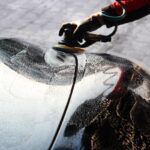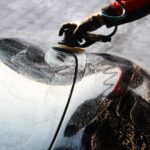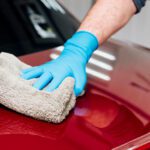Want to give your car a flawless shine that will make heads turn? Discover the expert techniques for a perfect hand wax finish.
In this guide, you will learn the secrets to achieving a showroom-quality shine right in your own driveway. By following these tried-and-true methods, you can transform your car's dull and lackluster exterior into a sleek and polished masterpiece.
From proper preparation to choosing the right wax and applying it with precision, you will be equipped with all the insider tips to achieve professional results.
So, get ready to elevate your car's appearance to the next level with these expert techniques for a perfect hand wax finish.
Proper Preparation for Hand Waxing
Before you begin hand waxing, it's important to regularly and thoroughly clean and dry the surface of the object you'll be waxing. Proper pre-wax cleaning ensures that the wax adheres properly and provides a smooth and shiny finish.
Start by washing the object with a mild soap or car wash solution to remove any dirt, dust, or grime. Rinse it thoroughly and dry it completely using a soft, lint-free cloth.
Next, inspect the surface for any old wax residue. If there's any, use a wax remover or a mixture of warm water and vinegar to gently remove the old wax. Be sure to follow the instructions on the wax remover and use a clean cloth to wipe away the residue.
Taking the time to clean and remove old wax will ensure that your hand wax finish is flawless.
Choosing the Right Wax for Your Car
To choose the right wax for your car, consider the specific needs and characteristics of your vehicle's surface. There are different types of car waxes available in the market, each with its own advantages and disadvantages. It is important to understand these options and factors to consider when choosing a wax for your car.
| Types of Car Waxes | Characteristics |
|---|---|
| Carnauba Wax | Provides a deep, glossy finish. May require more frequent reapplication. |
| Synthetic Wax | Offers longer-lasting protection and durability. May not give the same level of shine as carnauba wax. |
| Polymer Sealant | Creates a protective barrier against UV rays and contaminants. Offers superior durability. |
| Hybrid Wax | Combines the benefits of carnauba wax and synthetic or polymer sealants. Provides a balance of shine and longevity. |
Considering factors such as desired level of shine, longevity, and protection will help you make an informed decision about the right wax for your car. Once you have selected the appropriate wax, it's time to move on to the next step: applying the wax using the correct technique.
Applying the Wax Using the Correct Technique
Start by evenly applying a small amount of wax to the surface of your car using a soft cloth or applicator pad. This will ensure that the wax is distributed evenly and prevents any buildup in certain areas. When applying the wax, make sure to use gentle, circular motions to work it into the paint. Avoid applying too much pressure, as this can cause scratches or swirl marks. It's also important to use the right waxing tools and accessories, such as a microfiber cloth or foam applicator pad, to achieve the best results.
Common mistakes to avoid when applying wax include using too much wax, applying it in direct sunlight, and not allowing enough drying time.
Now that you have applied the wax correctly, it's time to move on to the next step: buffing and polishing for a flawless finish.
Buffing and Polishing for a Flawless Finish
To achieve a flawless finish, grab a microfiber cloth or foam pad and begin buffing and polishing the waxed surface of your car. This step is crucial to bring out the shine and make your vehicle look like it just rolled out of the showroom.
Start by applying light pressure and making small circular motions. Be sure to cover the entire surface evenly and avoid applying too much pressure as it can damage the wax.
One common mistake to avoid is using too much wax, which can lead to streaks and a dull finish. Another mistake is using a dirty or abrasive cloth, which can cause scratches.
Take your time and focus on the finishing touches for a showroom shine.
Maintaining the Waxed Surface for Long-Lasting Protection
To maintain the waxed surface and ensure long-lasting protection, you need to regularly clean and care for your vehicle. Here are some important tips to help you keep your waxed surface looking great:
- Waxing frequency for optimal protection: It's recommended to wax your vehicle every three to four months or as needed. Regular waxing helps to maintain a strong protective layer on your vehicle's paintwork.
- Benefits of using a sealant after waxing: Applying a sealant after waxing provides an additional layer of protection. Sealants are designed to bond with the wax and create a long-lasting barrier against UV rays, water, and contaminants.
- Avoid harsh detergents: When cleaning your waxed surface, use a mild car shampoo and a soft sponge or microfiber cloth. Harsh detergents can strip away the wax and diminish its protective properties.
- Regular maintenance: Regularly wash your vehicle to remove dirt, dust, and other contaminants that can degrade the wax. Also, consider using a quick detailer spray between washes to enhance the shine and protection.
Conclusion
In conclusion, by following expert techniques for a perfect hand wax finish, you can achieve a flawless and long-lasting protection for your car's surface.
Proper preparation is the first step to ensure a successful waxing process. This involves thoroughly washing and drying your car to remove any dirt or debris. It's also important to inspect the surface for any imperfections that may need to be addressed before applying the wax.
Choosing the right wax is crucial to achieve the desired results. There are various types of waxes available, such as carnauba wax and synthetic wax. Consider factors such as durability, shine, and ease of application when selecting the wax that suits your needs.
Applying the wax with the correct technique is essential for an even and smooth finish. Start by applying a thin layer of wax to a small section of the car using a foam applicator pad or a microfiber cloth. Work in small circular motions, ensuring that the wax is evenly spread.
Buffing and polishing are the final steps to enhance the shine and remove any excess wax residue. Use a clean microfiber cloth or a buffing pad to gently buff the surface in straight lines. This will help to evenly distribute the wax and remove any streaks or smudges.
With regular maintenance, your car will continue to shine and be protected from the elements. Regularly washing your car and applying a fresh layer of wax will help to maintain its glossy appearance and protect it from dirt, UV rays, and other environmental factors.
So go ahead and give your car the love and care it deserves with a hand wax finish. Your efforts will be rewarded with a beautifully protected and shining car.



